Healing Our Watersheds: A Recap of Coastal Cleanup Month 2021

As the tide turns on Coastal Cleanup Month, our big waves of gratitude and appreciation roll in for all who took part. We embarked on Coastal Cleanup Month with the mission of Healing Our Watersheds together. Even though it was another year of uncertainty due to the pandemic, our Coastal Cleanup Month participants still made an impact while keeping one another safe.
Thank you for volunteering in a cleanup, joining us at a virtual event, supporting our fundraising efforts, and sharing your exciting cleanup stories with photos and videos. Collectively, our contributions cleaned up our beaches, wetlands, waterways, neighborhoods, and mountain trails.
Combining the Best of Both Waves: In-Person & Virtual in 2021
The COVID-19 pandemic reminds us that even when our world seems to be shut down, the trash never stops. Pollution continues to wreak havoc locally and globally in our watersheds and communities.
Last year, Heal the Bay expanded Coastal Cleanup Day to encompass the entire month. Our communities attended interactive virtual events and we encouraged self-guided cleanups throughout the month in order to do our part while protecting the health and safety of all.
Coastal Cleanup Month 2021 continued to highlight how cleanups can and should be done anywhere, anytime – not just along the coast. Our virtual events on Instagram Live and Zoom were led by scientists and experts who discussed environmental issues in Los Angeles County and focused on inclusive solutions.
This year — with careful planning and consideration — we were thrilled to bring back in-person cleanups on Coastal Cleanup Day in a limited capacity. In addition to self-guided cleanups throughout the month, we also wanted to safely come together outside to take action.
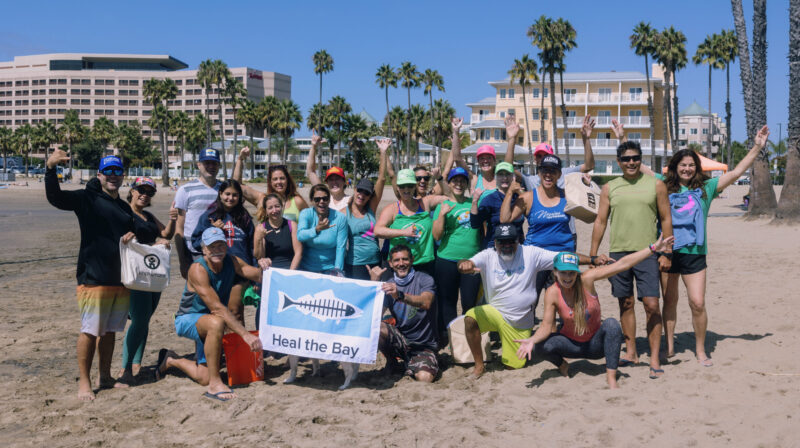
Emely Garcia, Coastal Cleanup Day Coordinator for Los Angeles County, praises the community effort to bring back safe, in-person cleanups for the big day, “The preparation and planning from our staff, site captains, and volunteers made this such a rewarding Coastal Cleanup Day. While this Coastal Cleanup looks much different than past years, it was wonderful being back in person, even at reduced capacity, protecting what we love.”
Coastal Cleanup Day would not have been possible without the leadership of our volunteer site captains across LA County:
Alex Preso, Anne Walker, Art Liem, Art Salter, Ashley Zarella, Barbara Gentile – Crary, Britany Goldsmith, Brittaney Olaes, Carl Carranza, Catherine Vargas, David Weeshoff, Don Nipper, Emily Parker, Fallon Rabin, Grace Young, Homin Houta, Jay Fodor, Joan Hernandez, Joel Glen, John La Rock, Karen Barnett, Lendi Slover, Leslie Cortez, Lois Brunet, Luke Ginger, Matthew Billinghurst, Maritza Toles, Nainoa Cravalho, Nick Shattuck, Patricia Jimenez, Patrick Tyrell, Roger Waiters, Say Craig, Supriyaa Singh, Tarry Kang, Terumi Toyoshima, and William Bowling.
A special THANK YOU to our site captains for leading the in-person effort on Coastal Cleanup Day!
Coastal Cleanup Month Results
This year, 4,708 volunteers across LA County collected over 30,000 pieces of trash during September for Coastal Cleanup Month.
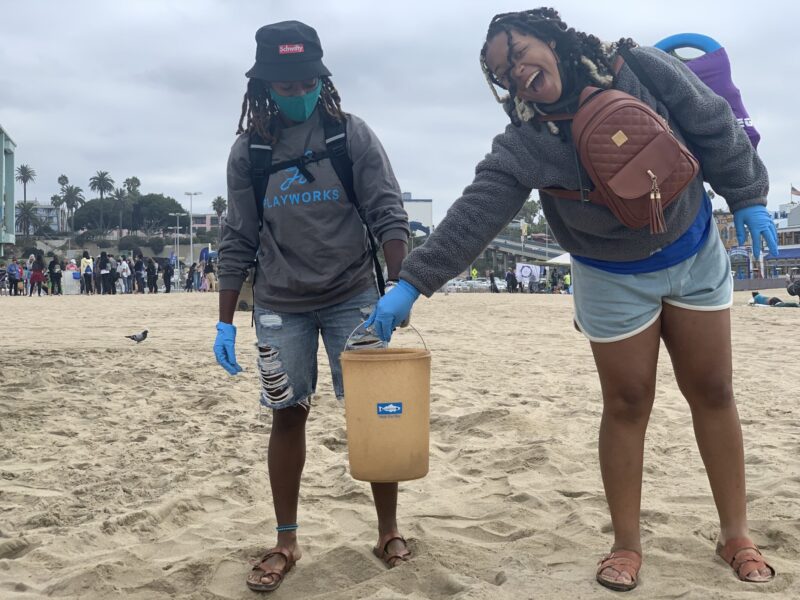
Coastal Cleanup Day
On Saturday Sept 18, we had 2,735 volunteers join us at 35 beaches, river, and inland sites across Los Angeles County, California to participate in Coastal Cleanup Day 2021.
In a span of three hours, our volunteers removed 5,051 pounds of trash and 156 pounds of recyclables. They covered 50+ miles of area on land and underwater, tracking their trash and memories as they went. 
Weird Finds
An Invisalign at the beach? A golf bag underwater? A traffic cone in the creek? It would not be Coastal Cleanup Day without a list of weird trash finds.
Here are a few of our favorites from Coastal Cleanup Day 2021:
- Barbie Doll head found in a tide pool (Surfrider Beach)
- Baby jumper car (Long Beach)
- Social Security Card (Santa Monica Beach – North)
- Student LAUSD Bus Pass from 2012 (Toes Beach)
- Fake $50 Bill and Pearl earring (Mother’s Beach)
- Bike wheel and pineapple (Ballona Wetlands)
Self-Guided Cleanups
973 self-guided cleanups took place all month long and were an essential part of Coastal Cleanup Month. Heal the Bay volunteers took initiative to clean up every aspect of our watershed over the four-week span, especially at their outdoor happy places. With sweat on their brow, smiles on their faces, and buckets full of trash, we want to highlight the amazing work of our 1,973 cleanup volunteers.
We had participants across our watershed; mountains – 42, neighborhoods – 183, waterways – 29, and beaches – 1,717.
Our Overall Impact
LA County’s Top 10 Trash Items
The results are in! Take a look at the top 10 trash items removed by volunteers in Los Angeles County during September 2021.
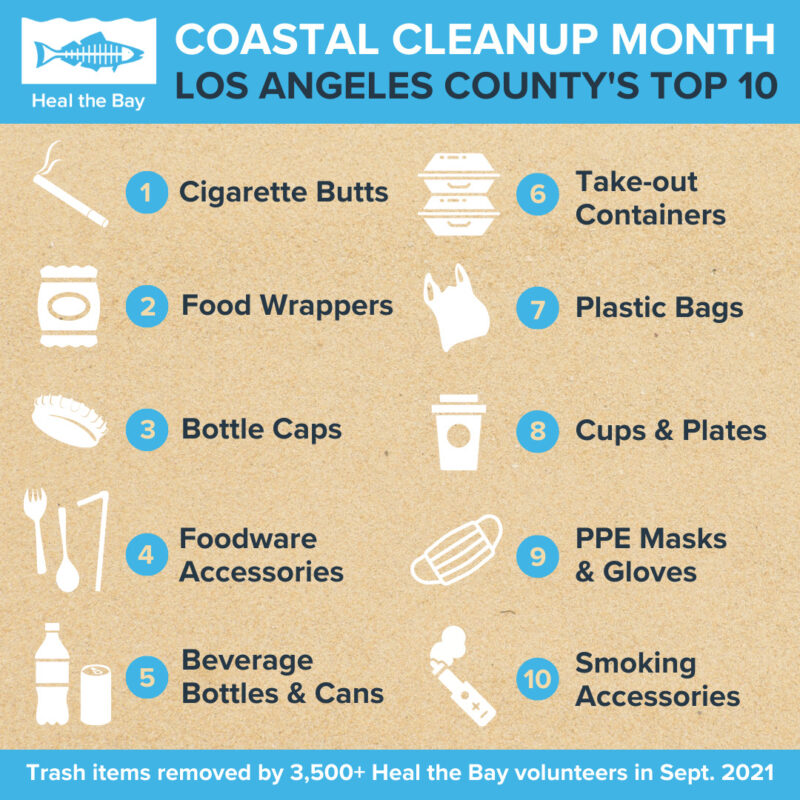
Why Do We Track Trash Data?
Data collected by volunteers during Coastal Cleanup Month is necessary in tracking local and global pollution trends. Our cleanup trash totals provide a snapshot of the current waste stream circulating here in Los Angeles and around the globe. This provides important baseline knowledge to inform and influence public policy and business practices for a healthier ocean, cleaner waterways, and safer communities.
As our top 10 trash items list displays, pollution from single-use plastic is the most prominent litter source in Los Angeles County.
PPE: Year Two of the Pandemic and its Impact on Our Environment
2020 was the first time we tracked the improper disposal of single-use personal protective equipment for LA County. Last year, it ranked #10 in the Top 10 Finds for Coastal Cleanup Month. This year, it ranks #9. Our data displays the negative impact the pandemic and sanitary measures have had on our waste stream, adding to another global problem: single-use plastic.
Problematic Plastic: The Takeover of Microplastics
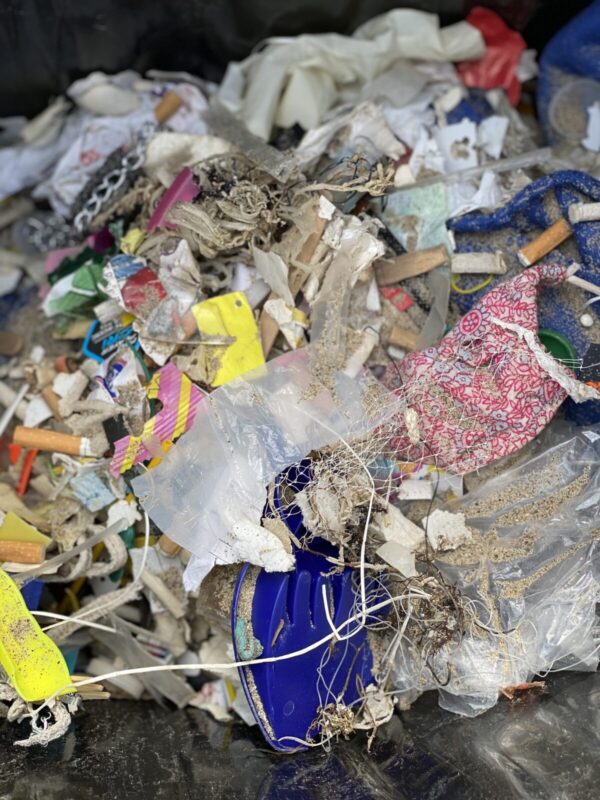
For both self-guided cleanups and in-person cleanup trash totals, the most frequent find was small plastic pieces. Our volunteers collected 6,547 plastic pieces. These problematic plastic pieces eventually break down into microplastics. Microplastics, which measure less than 5 mm, populate every aspect of our watershed — found in our water, the food we eat, and swirling around in our atmosphere. This is a worldwide crisis, not just for the environment but for humans as well.
As shown in our data above, single-use plastic from the food and drink industry are huge pollution sources, and eventual microplastic contributors as they breakdown in our environment. While cleanups aid in reducing the volume of plastic pieces that wind up in our watershed, we need to address the problem at the source. That’s why we’re fighting for effective plastic policies that limit the production of single-use plastic and make it easier for recyclable plastic to be disposed of properly.
Take Action: From Bills to Law, We Need Your Help
The California legislature introduced the Circular Economy Package in 2021 to fight plastic pollution. Here are three bills in the package that tackle plastic pollution, and could use your help to get signed into law:
Senate Bill 343: The Truth in Environmental Advertising Act
Have you ever turned over a plastic cup to see if it can be recycled, and noticed there is a number that’s encircled with the “chasing arrows” symbol. This leads you to believe it is recyclable, right?! Well, most of the time, it is not actually recyclable. SB 343 makes using the Reduce, Reuse, and Recycle symbol illegal if the item cannot actually be recycled. It only permits the use of the ♻️ symbol to be used on items that can be recycled in California. What a novel idea, huh! SB 343 helps to clarify what items should go in the recycling bin, reducing confusion among consumers while improving diversion rates. This means less waste is sent to landfill and more is actually recycled.
Assembly Bill 1276: Disposable Foodware Accessories
During the COVID-19 pandemic, many of us relied much more heavily on restaurant takeout and food delivery to feed ourselves and our loved ones while supporting local restaurants. The downside? Receiving disposable foodware accessories like cutlery, condiment packets, and straws that we don’t need and frequently end up in the trash without ever being used. These items, often made of single-use plastic, are clogging waste facilities and polluting our environment. AB 1276 would require foodware accessories only be provided upon explicit request of the customer, so you wouldn’t get them unless you ask.
Assembly Bill 962: California Beverage Container Recycling and Litter Reduction Act
What’s the best way to fight plastic pollution? Tackling the problem at the source. This bill focuses on replacing harmful disposable plastic items with sustainable reusable and refillable products. AB 962 promotes returnable and refillable beverage bottles in California by allowing glass bottles to be washed and refilled by beverage companies instead of crushed and recycled into new bottles – a much less energy-intensive process that encourages reuse and refill.
Take action! Urge Governor Gavin Newsom to sign the Circular Economy Package Into Law and many others here: https://camustlead.org/
Reduce Your Plastic Pollution EVERY DAY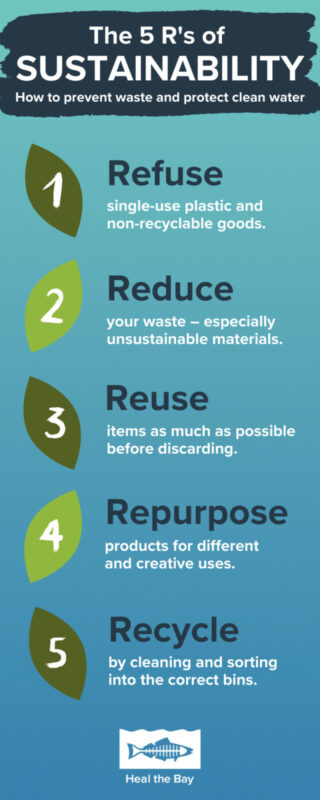
In addition to urging the California Governor to sign strong anti-pollution policies into law, you can make changes every day to reduce the amount of plastic waste that enters our watershed.
Expanding upon the eco-friendly concept of reduce, reuse, and recycle, we encourage you to go two steps further before recycling an item: refuse and repurpose. Incorporating the 5 R’s of sustainability into your daily decision-making as a consumer will limit the expulsion of single-use plastic waste and its effects on our environment.
Before throwing an item in the trash, we encourage you to walk through these five steps:
- Refuse
- Reduce
- Reuse
- Repurpose
- Recycle
Disposing plastic waste properly is important, but we must acknowledge that the prevalence of plastic in our world is not a burden that falls solely on the consumer – producers, we’re looking at you too! By using your voice to influence public policies and business practices for a plastic-free future, you are holding companies and corporations accountable for the waste they create.
Coastal Cleanup Month shows us that when communities work together, we make a big splash. This shared work must continue, and we must protect what we love every day.
Stay involved and support our clean water mission year-round with Adopt-a-Beach, Club Heal the Bay, Suits on the Sand, and MPA Watch. Sign up for our Blue Newsletter and Action Alerts to stay in the loop on our current science, advocacy, community action, and education programs and campaigns.
And don’t forget to save the date on Saturday, September 17, 2022, for next year’s Coastal Cleanup!
Big Wave of Thanks
As we reflect on our goals and impact from Coastal Cleanup Month 2021, we want to thank our amazing partners who helped make our in-person and virtual programming possible:
Portland Potato Vodka
Ocean Conservancy
California Coastal Commission
Water for LA
City of Santa Monica
TIME TO ACT Entertainment
Also, special thanks to Kelsey Davenport, our poster designer, and Steve Nguyen, our animated video creator for their amazing artistic contributions.





